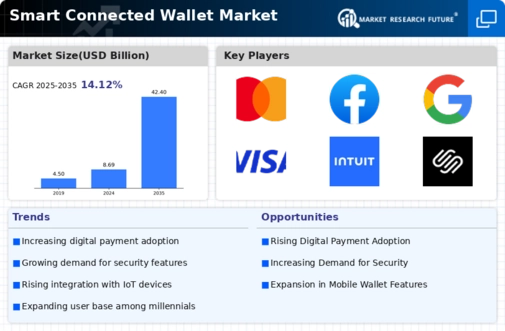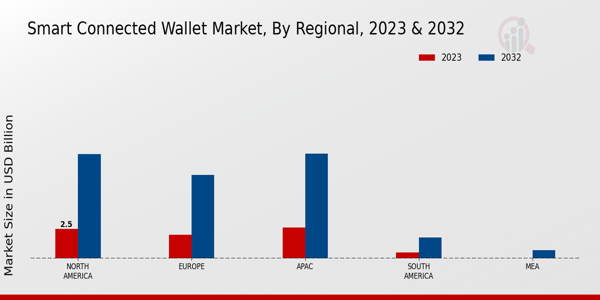Growing E-commerce Sector
The expansion of the e-commerce sector significantly impacts the Global Smart Connected Wallet Market Industry. As online shopping continues to gain traction, consumers increasingly seek convenient payment options that smart wallets provide. The projected growth of the market to 42.4 USD Billion by 2035 underscores the importance of e-commerce in driving smart wallet adoption. Retailers are also integrating smart wallet solutions to enhance customer experiences and streamline payment processes. This symbiotic relationship between e-commerce and smart wallets suggests a robust growth trajectory for the Global Smart Connected Wallet Market Industry, as more consumers opt for digital payment methods in their online shopping endeavors.
Market Growth Projections
The Global Smart Connected Wallet Market Industry is poised for substantial growth, with projections indicating a market size of 42.4 USD Billion by 2035. This growth trajectory is underpinned by a compound annual growth rate (CAGR) of 15.51% from 2025 to 2035. Such figures suggest a robust demand for smart wallet solutions as consumers increasingly embrace digital payment methods. The market's expansion is likely to be driven by various factors, including technological advancements, changing consumer preferences, and the growing e-commerce sector. These projections highlight the dynamic nature of the Global Smart Connected Wallet Market Industry and its potential for future development.
Increased Smartphone Penetration
The Global Smart Connected Wallet Market Industry is significantly influenced by the increasing penetration of smartphones across the globe. As smartphone ownership rises, more consumers gain access to mobile wallets, which facilitate easy and quick transactions. In 2024, the market is expected to reach 8.69 USD Billion, driven by the growing number of smartphone users who prefer digital payment methods. This trend is particularly pronounced in emerging markets, where mobile devices serve as primary access points to financial services. Consequently, the proliferation of smartphones is a key driver of growth in the Global Smart Connected Wallet Market Industry, enabling wider adoption of smart wallet solutions.
Rising Adoption of Digital Payments
The Global Smart Connected Wallet Market Industry experiences a notable surge in the adoption of digital payment solutions. As consumers increasingly prefer cashless transactions, the demand for smart connected wallets grows. In 2024, the market is projected to reach 8.69 USD Billion, reflecting a shift towards convenience and security in financial transactions. This trend is further supported by the proliferation of smartphones and mobile applications, which facilitate seamless payment experiences. Governments worldwide are also promoting digital payment initiatives, enhancing the overall ecosystem. Consequently, this driver is pivotal in shaping the future landscape of the Global Smart Connected Wallet Market Industry.
Regulatory Support for Digital Finance
Regulatory frameworks supporting digital finance initiatives are pivotal in shaping the Global Smart Connected Wallet Market Industry. Governments are increasingly recognizing the importance of fostering a conducive environment for digital payments, leading to the establishment of favorable regulations. Such policies not only enhance consumer confidence but also encourage businesses to innovate and adopt smart wallet technologies. For instance, initiatives aimed at promoting financial inclusion and reducing cash dependency are gaining momentum globally. This regulatory support is likely to stimulate growth in the Global Smart Connected Wallet Market Industry, as it creates a more favorable landscape for the adoption of smart connected wallets.
Technological Advancements in Security Features
Technological innovations play a crucial role in the Global Smart Connected Wallet Market Industry, particularly concerning security features. Enhanced biometric authentication, encryption, and tokenization technologies are being integrated into smart wallets, addressing consumer concerns about data security. As cyber threats evolve, the implementation of advanced security measures becomes imperative. For instance, the introduction of facial recognition and fingerprint scanning has significantly improved user trust in digital wallets. This focus on security not only attracts more users but also encourages businesses to adopt smart wallet solutions. Thus, the ongoing advancements in security technology are likely to drive growth in the Global Smart Connected Wallet Market Industry.























Leave a Comment